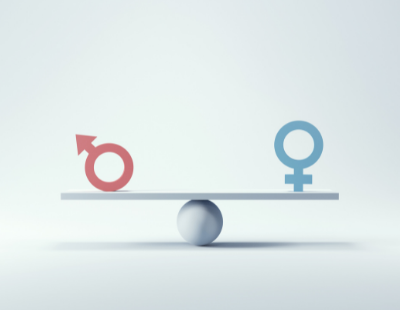With an annual gross income of £38,061, the average British male requires 7.3 times their annual salary in order to cover the current average property price of £278,120.
In contrast, the average British female requires 11.1 times her average annual income of £25,154 to cover the same cost – almost four years more than her male counterpart.
How does the house price affordability gap differ by region?
On a regional scale, London is predictably home to the largest gender house price affordability gap.
The average male in the capital would require 10.3 times their current annual gross earnings to cover the cost of a London property (£521,146), while this climbs to 15.6 for a female homebuyer – a gap of 5.3 years.
The South East (5.2), South West (5.1) and East of England (5) are also home to a gender house price affordability gap of five times annual salary or more.
Even in the North East where this gap is at its smallest, the average female still requires almost two years (1.8) additional earnings to cover the cost of a property versus the earnings required from a male homebuyer.
Worst areas for women to buy a home
When it comes to the worst pockets of the property market to be a woman, Kensington and Chelsea ranks top.
While the average male in the borough requires a hefty 12.7 times their average annual earnings to cover the current cost of a Kensington property, this shoots up to a staggering 36.6 times annual earnings for the average female – a gap of 23.9.
Rother (10.5), Mole Valley (10.2), Rutland (9.8) and Camden (9.3) also rank amongst the worst property markets for female buyers.
Best areas for women to buy a home
Although the figures present a bleak picture for female homebuyers, there are a number of areas where gender property purchasing power sits on a relatively level playing field.
In Inverclyde. the average woman earns £24,619 versus an annual gross income of £27,542 for the average male. This means that the average female needs 5 years annual income to cover the average cost of a property, while the average male needs 4.5 years – a gap of just half a year.
Across both Rushmoor and Blackpool, the gender house price affordability gap also sits below a year’s earnings (0.9) between both the average male and female homebuyer.
Meanwhile, in Copeland, Anglesey, Tunbridge Wells and Falkirk, the average female requires just one additional year of income to cover the cost of a property when compared to her male counterpart.
What do experts say?
Athena Hubble, managing director of Boomin, comments: “Fortunately I’ve been able to purchase properties but there are so many females out there who struggle to get on the property ladder.”
She says the gender pay gap is a ‘significant mismatch’ that women are reminded of every time they receive their monthly payslip, and it stretches beyond the workplace into other areas of life.
“Our purchasing power within the property market is certainly one of those areas, and the disparity in pay between men and women has a huge influence on what we are able to borrow. As a result, many women are priced out of homeownership unless they accept that the only path in achieving it is with a significant other.”
Michael Bruce, Boomin’s chief executive officer and founder, adds: “The financial barrier to homeownership has grown significantly in recent times and it continues to do so, as aspirational buyers push for this coveted status in a market where stock levels are simply insufficient.”
“This struggle isn’t gender-specific and for many, getting a foot on the ladder is only made possible with the help of a parent, or as a combined effort with a partner.”
He concludes: “However, this shouldn’t detract from the fact that there is a huge gap when it comes to the individual purchasing power of both men and women and this comes as a direct consequence of the gender pay gap found across society.”
|
Table shows the average house price affordability ratio of both men and women and the gap between the two
|
|
Location
|
Current average house price
|
Male average gross earnings
|
Male house price affordability ratio
|
Female average gross earnings
|
Female house price affordability ratio
|
Gender house price affordability gap
|
|
London
|
£521,146
|
£50,592
|
10.3
|
£33,413
|
15.6
|
5.3
|
|
South East
|
£380,237
|
£42,580
|
8.9
|
£26,822
|
14.2
|
5.2
|
|
South West
|
£314,037
|
£34,267
|
9.2
|
£22,028
|
14.3
|
5.1
|
|
East of England
|
£339,502
|
£40,106
|
8.5
|
£25,121
|
13.5
|
5.0
|
|
West Midlands Region
|
£238,238
|
£35,490
|
6.7
|
£23,331
|
10.2
|
3.5
|
|
East Midlands
|
£235,004
|
£34,106
|
6.9
|
£22,670
|
10.4
|
3.5
|
|
Yorkshire and The Humber
|
£196,877
|
£33,632
|
5.9
|
£22,111
|
8.9
|
3.1
|
|
Wales
|
£204,835
|
£32,067
|
6.4
|
£22,496
|
9.1
|
2.7
|
|
North West
|
£200,172
|
£33,865
|
5.9
|
£23,352
|
8.6
|
2.7
|
|
Scotland
|
£180,485
|
£35,137
|
5.1
|
£25,333
|
7.1
|
2.0
|
|
North East
|
£147,214
|
£31,187
|
4.7
|
£22,452
|
6.6
|
1.8
|
|
England
|
£293,339
|
£38,658
|
7.6
|
£25,291
|
11.6
|
4.0
|
|
Great Britain
|
£278,120
|
£38,061
|
7.3
|
£25,154
|
11.1
|
3.7
|
| |
|
|
|
|
|
|
|
Table shows the areas with the largest gap between the male and female house price affordability ratio
|
|
Location
|
Current average house price
|
Male average gross earnings
|
Male house price affordability ratio
|
Female average gross earnings
|
Female house price affordability ratio
|
Gender house price affordability gap
|
|
Kensington and Chelsea
|
£1,374,008
|
£108,144
|
12.7
|
£37,518
|
36.6
|
23.9
|
|
Rother
|
£358,606
|
£42,358
|
8.5
|
£18,956
|
18.9
|
10.5
|
|
Mole Valley
|
£530,845
|
£59,753
|
8.9
|
£27,854
|
19.1
|
10.2
|
|
Rutland
|
£351,728
|
£41,815
|
8.4
|
£19,264
|
18.3
|
9.8
|
|
Camden
|
£915,362
|
£54,801
|
16.7
|
£35,217
|
26.0
|
9.3
|
|
New Forest
|
£399,060
|
£40,118
|
9.9
|
£21,083
|
18.9
|
9.0
|
|
Dacorum
|
£458,761
|
£44,274
|
10.4
|
£23,943
|
19.2
|
8.8
|
|
Bath and North East Somerset
|
£399,981
|
£39,534
|
10.1
|
£21,181
|
18.9
|
8.8
|
|
St Albans
|
£576,855
|
£66,830
|
8.6
|
£33,255
|
17.3
|
8.7
|
|
Castle Point
|
£352,804
|
£43,726
|
8.1
|
£21,047
|
16.8
|
8.7
|
| |
|
|
|
|
|
|
|
Table shows the areas with the smallest gap between the male and female house price affordability ratio
|
|
Location
|
Current average house price
|
Male average gross earnings
|
Male house price affordability ratio
|
Female average gross earnings
|
Female house price affordability ratio
|
Gender house price affordability gap
|
|
Inverclyde
|
£123,884
|
£27,542
|
4.5
|
£24,619
|
5.0
|
0.5
|
|
Rushmoor
|
£317,880
|
£35,164
|
9.0
|
£32,121
|
9.9
|
0.9
|
|
Blackpool
|
£130,372
|
£24,644
|
5.3
|
£21,171
|
6.2
|
0.9
|
|
Copeland
|
£136,773
|
£40,087
|
3.4
|
£31,095
|
4.4
|
1.0
|
|
Isle of Anglesey
|
£224,057
|
£28,880
|
7.8
|
£25,618
|
8.7
|
1.0
|
|
Tunbridge Wells
|
£419,429
|
£35,638
|
11.8
|
£32,750
|
12.8
|
1.0
|
|
Falkirk
|
£155,018
|
£30,984
|
5.0
|
£25,627
|
6.0
|
1.0
|
|
City of Dundee
|
£144,367
|
£29,040
|
5.0
|
£23,751
|
6.1
|
1.1
|
*Current average house price data sourced from the Gov.uk UK House Price Index (December 2021 - latest available).
*Average earnings sourced from the Office for National Statistics - Employee earnings in the UK: 2021
*Affordability ratio based on house prices divided by earnings. A ratio of five, for example, would mean five years of full gross earnings are required to cover the average cost of a home.
To view part one of the IWD series, featuring words from female trailblazers in the property industry, click here.



















Join the conversation
Be the first to comment (please use the comment box below)
Please login to comment